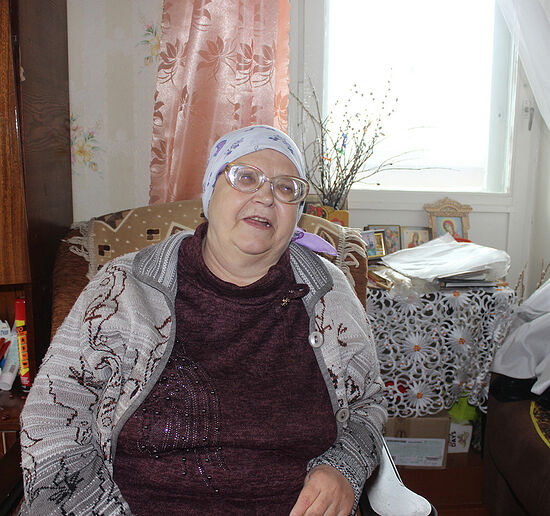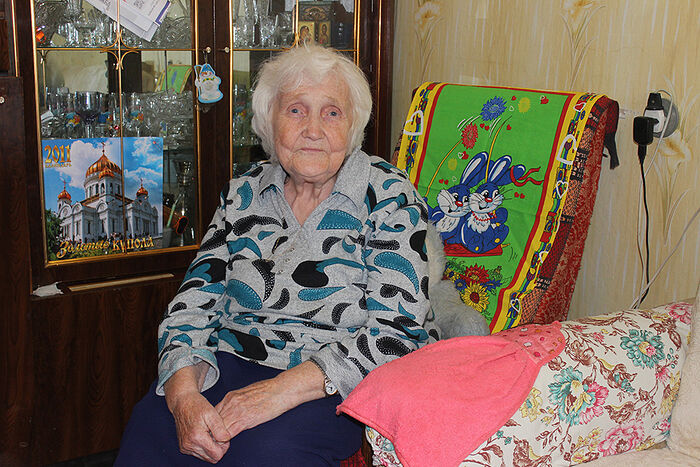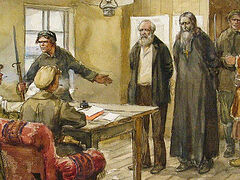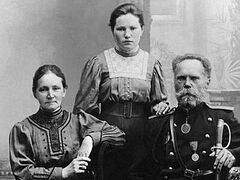From Catholicism to Orthodoxy
I met another parishioner of the church of the Holy Hieromartyr Herman (Ryashentsev) in the settlement of Puteyets—Ludmila Filippova. Her parents used to call her Ludvika.
“Where does your unusual name come from? I asked.”
“My mother and father gave it to me. My parents met and were married in the Pechora village of Taly, where they were exiled. My father, Iosif Vikentievich Konovka, was from Belarus, and my mother, Aldona Avgustovna, was from Lithuania. They were the ones who built this village, recalls Ludmila Iosifovna. “My parents were Catholics.”
“How did you end up in Naberezhny then, with the Orthodox name Ludmila?” I eagerly asked to hear the rest of her life story.
“Oh, it’s very simple!” she smiled. “After graduating from the Syktyvkar Cultural and Educational College, I was sent by distribution first to the Pechora village of Kadzherom, and then the head of the cultural department, Ivan Artemenko, advised me to go to the Industrial Complex; that’s what our Naberezhny was called at first. ‘As soon as you pass the Pechora Bridge, get off right away,’ Ivan Zakharovich warned me. So I ended up in Naberezhny. I was only nineteen years old at the time.”
As custodian of the local cultural center, Liudmila faced many trials. But she still cannot stop marveling at how multicultural the settlement was at the time.
“We had Georgians and Chechens living here,” Ludmila Iosifovna recounted. “Many of them were exiled settlers. When you’d drive into Naberezhny, there used to be a whole settlement of them, with their own shops.”
From further conversation with Ludmila Filippova, I learned that the prison settlement was located just past the bus stop in Naberezhny, opposite the school. Today there is an open field there, with nothing to indicate that there was once an open correctional institution there.
“The entire multicultural population of the settlement would gather at the cultural center for dances. And as soon as the dances in the club ended, I had to go with a bucket of water and pour it into the cracks in the floor, where the club visitors threw cigarette butts. That’s how we tried to prevent the building from catching fire...” she went on.
But as she recalls, fights would also break out in the club, and someone told young Ludmila Iosifovna that she should come between the conflicting parties in such situations...
“Well, I did just that!” she laughed. “And then my future husband grabbed me by the collar and yelled, “What are you doing!” then made me go up to the second floor and locked me in one of the rooms. In the courtyard of the cultural center they were tearing down all the fences. The next day, people wanted to go to the club to dance, but I didn’t open it. ‘Open up, and we’ll put up a fence for you!’ they promised me. So this unpleasant incident was resolved, and the club got a new fence,” Ludmila Iosifovna concluded her series of reminiscences about cultural life in the settlement during the last century. But over the eight decades of the village’s existence, a church or chapel has never been built here.
But Liudmila Iosifovna is a parishioner, as I mentioned earlier, of the church in the village of Puteyets. And in order for her to be able to attend an Orthodox church, she converted from Catholicism to Orthodoxy.
“I didn't even need to prepare for this important event in my life! The thing is, due to a progressive eye disease— glaucoma in one eye, and the other can only see thirty percent—I had already memorized many Orthodox prayers by heart in advance. But still, before making the decision, I thought for a long time: How will I convert from Catholicism to Orthodoxy? After all, Catholicism is the faith of my parents and many relatives... And the priest didn’t rush me, he just said to come for the sacrament of Baptism as soon as I was ready. But at the same time, while still a Catholic, I continued to go to the Orthodox church, where parishioners looked at me askance: "Why do you go to an Orthodox church if you’re Catholic?” I often heard from them.
Then at one point such sadness came over me, and Matushka Natalia, the priest’s wife, called me and was surprised to hear my upset voice. Then the priest himself called me and said, “That’s it, Liudmila, come to the church on the feast of Sts. Peter and Paul, and we will baptize you!” So he baptized me into Orthodoxy, and I immediately felt lighter in my soul. But after this important event in my life, my Catholic relatives started to judge me... But I no longer wanted any faith other than Orthodoxy. Before this important event, I had a very difficult situation in my family—my husband died at the age of fifty-five, and my son was on near death. But after accepting Orthodoxy, I received Divine comfort...
There will be no one to take care of the chapel
However, despite her love for Orthodoxy, Ludmila Iosifovna also believes that there is no point in building a chapel in Naberezhny. Instead, she says, the churches in neighboring villages such as Iz’yay and Ozyornoye should be completed, and residents of Naberezhny could attend services there.
“There will be no one to take care of the chapel in our village”, Ludmila Iosifovna comments. |We are old, and won’t be able to do it anymore. But what are the kids like today? They’ll want to smoke and drink—and God forbid, all of this will happen in the chapel.”
At the end of our conversation, Ludmila Filippova showed us the icon corners in her apartment. And like the others I talked with in Naberezhny, Ludmila Iosifovna has them in every room.
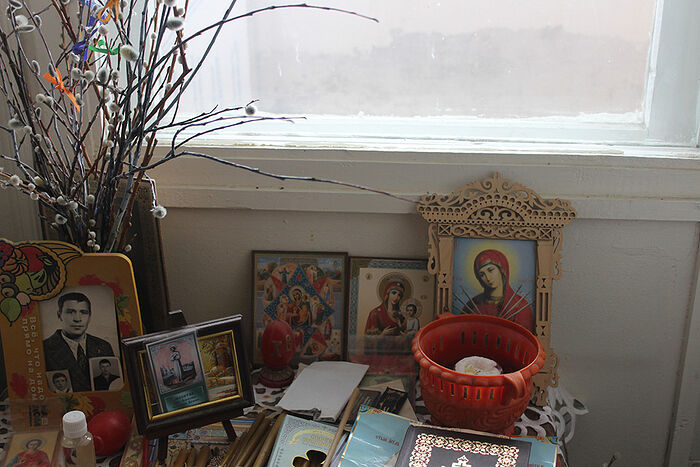 A table with icons and family photos at Liudmila Filippovna’s house.
A table with icons and family photos at Liudmila Filippovna’s house.
Next to the icons, the woman had also placed portraits of her loved ones who are dearly missed...
“Here I have a corner arranged for prayers, right next to the icons there is also a portrait of my husband. When the priest blessed the apartment, he was surprised that I had a photo of my husband next to the icons,” she smiles. My late husband’s partent were deeply religious people; they lived in a two-story house in the village of Bakur in the Izhma District of Komi, and they had many ancient icons. The priest gave me the ‘Burning Bush’ icon of the Mother of God for my home icon corner.”
Next to the icons, I saw prayers printed in large type so that Ludmila Iosifovna could read them.
“Our priest’s, son, Alexander, printed these prayers and spiritual verses for me,” Liudmila explained.
Visiting Maria Antonovna
In Naberezhny I had a meeting with its oldest resident, Maria Porubaeva. Maria Antonovna was originally from the village of Sizyabsk in the Izhma District of Komi, and after the war her mother brought her to the Pechora village of Ust-Kozhva.
“Her brother lived here, and he invited her to live with him and helped her find a job,” Maria Antonovna said.
Maria moved after marriage to Naberezhny—then prosaically named “Promkombinat” [Industrial Complex], in 1971.
“I married Giorgi Vasilyevich Porubaev, a veteran of the Great Patriotic War [World War II].”
“Where did your husband work in Naberezhny?” I asked her.
“At first, he worked as a cinema mechanic in our old club. We used to gather at the club for dances and concerts of local artists,” Maria Antonovna recalls. “Yes... the settlement was different in those days... bigger! And there were many residents. In those distant years, there were four stores in Naberezhny: with household goods, industrial goods, and two grocery stores. The houses were mostly wooden with wood heating, but the brick houses were built by the oil depot for its workers.
Loyalty to her beloved company
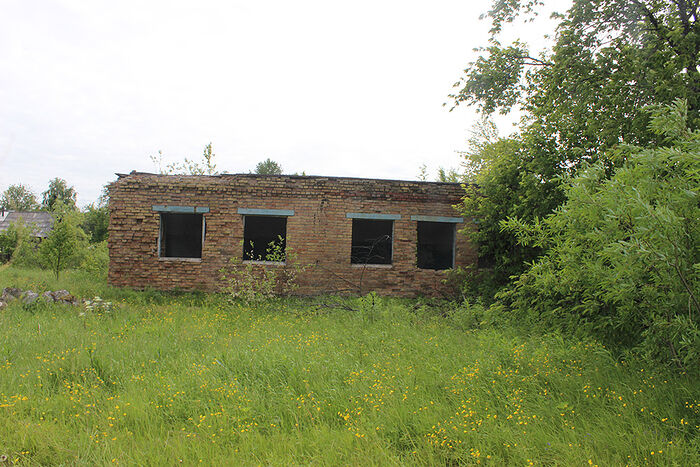 All that’s left of the Naberezhnaya sewing workshop
All that’s left of the Naberezhnaya sewing workshop
As I learned from our conversation, Maria Antonovna had worked for thirty-two years as an accountant in the Naberezhny sewing workshop.
“I retired from there. After that, the workshop continued to work for some time. And then our seamstresses and tailors were transferred to the city of Pechora,” Maria Antonovna explained.
“I would gladly go to a church or chapel in our village!”
It seemed that we had discussed everything with the longtime resident of Naberezhny, Maria Porubaeva. But now it was time to talk to her about the main thing—the construction of a chapel in the village. And just as in the homes of my other acquaintances from Naberezhny, I saw icon corners in every room.
“In our hearts, we all believe,” she says. “And how can one live without God? When my loved ones go somewhere, I always bless them. And when you leave, I’ll also say to you, “God keep you!”
“But Maria Antonovna, there is no church or chapel in your village to pray for your loved ones, light a candle for them, attend a service...”
“Well, I didn’t really go to church before. Although we had a church nearby, I didn’t visit it. And now, especially at my age I won’t be able to go to church. I’ll pray at home in front of the icons and that’s it... But if we in Naberezhny had a chapel or a church built, I would gladly go to them!” Maria Antonovna suddenly declared.
Meeting at the paramedic-obstetric station
We gathered for a meeting with the residents in the paramedic-obstetric station to discuss the construction of a chapel and commemorating the prisoners of the GULAG. The station is located in the former office of the oil depot, so there are many rooms here; there is a waiting room, a reception room, a procedural room, and there is even enough space for visiting specialists from the city to work. I also noticed that there were icons in every room here as well. And the head of the station, Svetlana Evdokhenko, is a parishioner of one of the churches in the Pechora region.
The residents who came to see Svetlana Ivanovna talked to me about the need to build a chapel in the village, which they would like to dedicate to the Mother of God.
“There is a place for the construction of a chapel—near our dacha in Naberezhny there is a picturesque vacant lot on a high bank of the Pechora River,” commented Vera Galasheva, who had come to the meeting.
But after all the talk we had with the residents about the revival of spiritual life in the village, that’s where it has stopped for now. Indeed, not far from Naberezhny, two churches are being built in neighboring villages. But I also saw that there are many elderly people living in Naberezhny who, unfortunately, can no longer visit them. However, it was not possible to gather an group of people who would jointly take up this good work of building a chapel or erecting a Devotional Cross in Naberezhny.
At the sorrowful sites of Naberezhny
To conclude our work in Naberezhny, villager Ludmila Udovenko and I walked to the sorrowful sites that were pointed out to us by longtime residents of the village.
At the beginning of our walk, my companion showed me a hill—a burial site—that you pass by when you go from the station to the village. Today there are quaint country houses here.
Where I stopped to capture the beauty of this corner of the Pechora region, Ludmila Valentinovna reminded me that according to the testimony of Naberezhny old-timers, this is where the graves of prisoners who built the Pechora Bridge were located.
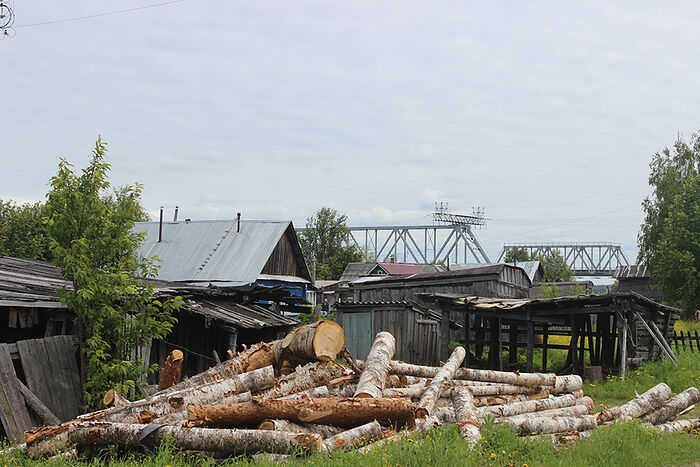 Life in Naberezhnaya goes on against the background of the Pechora Bridge
Life in Naberezhnaya goes on against the background of the Pechora Bridge
Another landmark for us in search of such sorrowful places was the ruined club building. As eyewitnesses had told Ludmila Valentinovna, prisoners were also buried not far from it.
“When the prisoners were brought on barges, they disembarked on the shore, where they lived and built the railway and the bridge. There were many deaths, and they were not taken far to be buried,” Ludmila Udovenko said. “And there were also burials on the very place where the House of Culture stood. The club in our village could not start its work for a long time, and many attributed this to the fact that it was built on a cemetery...”
Ludmila Valentinovna also reported that there had already been attempts to build a church and install a cross in Naberezhny in the past. The chairman of the village council was interested in this, and the residents were enthusiastic about his idea. They even found a place to install the cross, but everything stopped due to a lack of finances...
So, even now, I was unable to inspire the residents of Naberezhny to this noble cause for the memorial of all those who died a lay buried on this much-suffering land—the martyrs of the GULAG. But nevertheless, we did make progress in piecing together the village’s history and creating a photo archive of materials from former makeshift burials of prisoners and other places of sorrow, now only known to old-timers of Naberezhny.

